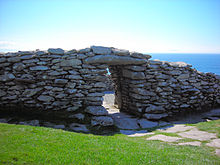- Corcu Duibne
-
 An Ogam inscribed stone found at Ballintaggart, County Kerry. The text is read as "MAQQI IARI (K)[OI] MAQQI MUCCOI DOVVINIAS", commemorating a member of the Corco Duibne. Drawn by Cork architect and antiquarian Richard Rolt Brash (1817–1876) and published in 1879 in his posthumous work The Ogam Inscribed Monuments of the Gaedhil in the British islands.
An Ogam inscribed stone found at Ballintaggart, County Kerry. The text is read as "MAQQI IARI (K)[OI] MAQQI MUCCOI DOVVINIAS", commemorating a member of the Corco Duibne. Drawn by Cork architect and antiquarian Richard Rolt Brash (1817–1876) and published in 1879 in his posthumous work The Ogam Inscribed Monuments of the Gaedhil in the British islands.
The Corcu Duibne was a notable kingdom in prehistoric and medieval County Kerry, Ireland which included the Dingle Peninsula, the Iveragh Peninsula and connecting lands. The tribe belonged to the Érainn and claimed descent from the legendary Conaire Mór, possibly making them distant cousins of such far off kingdoms as Dál Riata in Ulster and Scotland, as well as the closer Múscraige and Corcu Baiscind.[1] All the tribes belonged to the Síl Conairi of legend and ultimately traced their descent from the Clanna Dedad.
Contents
Septs and relations with other kingdoms
The ruling septs of the Corcu Duibne were O'Shea and O'Falvey, and possibly O'Connell.[2]
Noted creators of ogham inscriptions, with over one third of all Irish inscriptions found in their region,[3] the existence of the Corcu Duibne is attested as early as the 5th century.[4] These tell us they claimed descent from a female ancestor DOVINIA.[5][6][7]
The Iron Age mountaintop fortress Caherconree, preserving the name of the legendary Cú Roí, a cousin of Conaire Mór, is found on the Dingle Peninsula, the name of which in Modern Irish is Corca Dhuibhne.
Relations between the Corcu Duibne and the nearby Eóganacht Locha Léin are poorly understood, but it appears they spent at least some period of time under the nominal overlordship of the latter in the powerful but relatively short-lived Kingdom of Iarmuman.[8] Rule from distant overkingdom of Eóganacht Chaisil is not apparent and so it is likely that the Corcu Duibne kingdom had an independent, if remote, existence in the first millennium.
Legendary origins
The 8th-century text known as The Expulsion of the Déisi attributes to the Corcu Duibne an eponymous founder, Corc Duibne, a scion of the branch of the Érainn royal line called the Síl Conairi, after Conaire Mór. In particular, the later "B version" of the text includes a lengthy episode describing Corc's birth and childhood deeds. Corc and his twin brother Cormac are born of incest to Coirpre Músc (a quo Múscraige) and Duihind, children of Conaire Cóem, a descendant of Conaire Mór. Their conception causes the crops to fail, and the people determine to immolate them to remove their curse. However, a druid steps in and offers to take Corc to an offshore island so that the abomination is out of Ireland. Reciting a poem predicting great things for Corc's descendants, the druid and his wife Boí take the boy to the remote island of Inis Boí. Every morning for the next year, Boí performs a purification ritual in which she gives Corc an ablution while he is seated on the back of an otherworldly white cow with red ears. Finally one morning Corc's curse leaves him and enters the cow, who jumps into the ocean and turns to stone, becoming the rock of Bó Boí. Boí takes Corc to his grandmother, Sárait, daughter of Conn Cétchathach, and eventually convinces her to take him back.[9]
When he is older Corc is sent to serve as hostage in the court of Cormac mac Airt, King of Tara. There he is fostered by Óengus Gaíbúaibthech, a leader of the Déisi. When Óengus and his people are expelled from Tara over a bloody dispute with the king's son, Corc absconds from hostageship and joins his foster-father, fighting beside him in many battles. Eventually the Déisi wander to the southern coast, and come to the island where Corc was reared. He tries to convince them to settle there, but they elect to move farther north. Corc remains, and founds his dynasty.[10]
Notes
- ^ Byrne, pp. 63, 171, 174
- ^ Mumu, the Kingdom of Munster
- ^ MacNeill 1909, p. 334
- ^ MacCotter, p. 168
- ^ Byrne, pp. 166-7
- ^ MacNeill 1909, p. 334
- ^ MacCotter, p. 168
- ^ Byrne, p. 207
- ^ This Is The Cause Of The Expulsion Of The Déssi To Munster And The Violent Death Of Cormac, sect. 9–11.
- ^ This Is The Cause Of The Expulsion Of The Déssi To Munster And The Violent Death Of Cormac, sect. 5; 8; 12.
References
- Francis John Byrne. Irish Kings and High-Kings. Four Courts Press. 2nd revised edition, 2001.
- Vernam Hull. "The Later Version of the Expulsion of the Déssi", in Zeitschrift für celtische Philologie 27 (1958-9): 14-63.
- Paul MacCotter. Medieval Ireland: Territorial, Political and Economic Divisions. Four Courts Press. 2008.
- Eoin MacNeill. "Early Irish Population Groups: their nomenclature, classification and chronology", in Proceedings of the Royal Irish Academy (C) 29. 1911. pp. 59–114
- Eoin MacNeill. "Notes on Irish Ogham Inscriptions", in Proceedings of the Royal Irish Academy. 1909. pp. 329–70
- T. F. O'Rahilly. Early Irish History and Mythology. Dublin Institute for Advanced Studies. 1946.
Categories:- Medieval Gaels
- Ancient peoples
- Ancient Ireland
- Kingdoms of ancient Ireland
Wikimedia Foundation. 2010.

